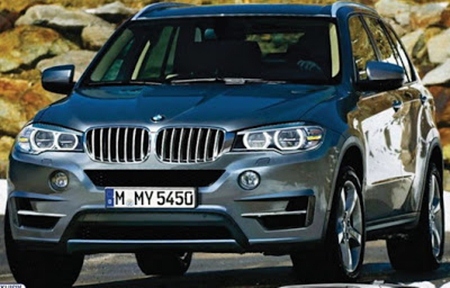The third-generation BMW X5 will be sold with 2.0 liter four cylinder diesel engine and optional rear-wheel-drive which results in an SUV with claimed combined cycle fuel consumption of just 5.6 liters per 100 km. BMW also quote the emissions, but to be honest I have never met anybody who gives a damn (but if you do, it’s 149 g/km).
The decision to expand the choice of engines with the new BMW luxury SUV to include a four-cylinder engine is similar to Mercedes-Benz which has done the same with its latest ML Class.
The new X5 is a typical BMW evolutionary approach that sees it retain its upright profile and traditional features such as its two piece tailgate.
 New BMW X5.
New BMW X5.
Distinguishing touches include a bolder front end with a more prominent kidney grille, LED imbued headlamps that butt up against the chrome surround of the grille and a more heavily contoured bumper with so-called air curtain ducts on the lower outer edges that help to channel air more efficiency through the front wheel houses to a vertical duct sited behind the front wheel arches called the air blade, as seen on the recently introduced 3-Series GT. Whether or not these actually work at built up road speeds is a moot question, but I am sure they do on the unrestricted autobahns.
Prominent tall windows remain a key design feature – following on from the original model (codename E53) launched in 1999 and second-generation model (E70) in 2008.
This new X5 is fairly large, at 4886 mm in length, 1938 mm in width and 1762 mm in height, and is 32 mm longer, 5 mm wider and 14 mm taller than the current X5. It shares its 2933mm wheelbase with the current X5 but the front and rear tracks have been shortened by 4mm both front and rear to 1640mm and 1646mm, endowing it with a slightly smaller footprint.
Inside, the new X5 has a more luxurious interior with the option of two rear seat configurations: a fixed 40:20:40 bench arrangement and a newly developed bench configured in a 70:30 arrangement that adjusts lengthwise to free up leg space for an optional third row of seats that now come with a so-called comfort seat option.
Boot capacity for the new X5 is up by 30 liters at 650 liters, rising to 1870 liters when the second and third seat rows are folded away.
This coming X5 comes with a long list of advanced optional extras. Included is a head-up display, night vision with human and animal detection and a spot light function, lane departure warning, lane change warning, road sign recognition, a 360 degree surround view parking assistant with longitudinal and lateral guidance and collision warning and pedestrian warning with an automatic braking function.
Infotainment features includes full internet access, in-car use of Facebook, Twitter and other on-line services as well as a dictation function with speech recognition for e-mails, SMS text messages.
For a standard xDrive30d guise, BMW claims a kerb weight of 2070 kg – 80 kg less than the outgoing model despite the slight increase in external dimensions and more flexible interior appointments.
Buyers will be able to choose between four different suspension tunes: a basic steel sprung set-up and three optional suspension set-ups with air springs – comfort, dynamic and professional. The latter two come with adaptive damping and also receive BMW’s Dynamic Performance Control system, as seen on the X6, with a mechanically operated torque vectoring system on the rear axle for added agility.
The new X5 will be sold with the choice of three engines. All will come mated to an updated version of BMW’s eight speed automatic gearbox with new stop/start and coasting functions, bringing about improved performance credentials and reduced combined cycle fuel consumption that sees them meet the upcoming tough new EU6 emission regulations due to come into force in September 2014. All diesel units receive urea injection for reduced nitrous oxide (NOX) emissions. Four-wheel-drive will remain standard on all but two models.
The engine range includes a turbocharged 4.4 liter V8 petrol unit that produces 330 kW in the xDrive50i, a turbocharged 3.0 liter in-line six cylinder common rail diesel with 190 kW in the xDrive30d and BMW’s triple turbocharged 3.0 liter in-line six cylinder common rail diesel producing 280 kW in the performance orientated xDrive M50d, which is claimed to hit 100 km/h from standstill in 5.3 seconds, reach a top speed limited to 250 km/h while returning 6.7 L/100 km.
Other engines available includes the turbocharged 2.0 liter diesel producing 160 kW. This new base engine will be available in both the four-wheel-drive xDrive25d and, in a first for the X5, rear-wheel-drive sDrive25d.
Also planned is a powered up version of the turbocharged 3.0 liter in-line six cylinder common rail diesel with 230 kW in the xDrive40d and a turbocharged 3.0 liter in-line six cylinder petrol engine with 225 kW in the Xdrive35i.




